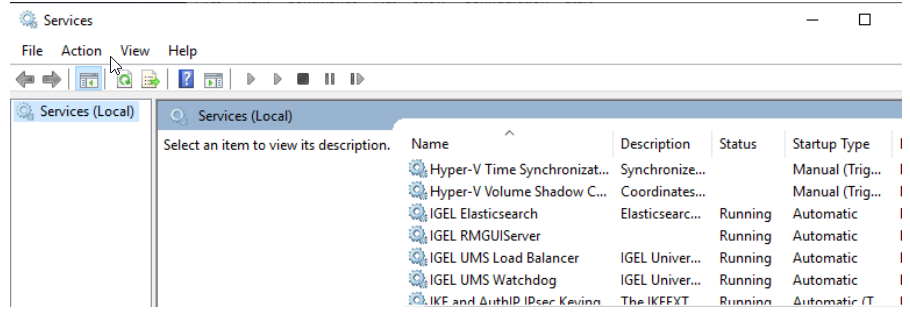How to Migrate a UMS High Availability Installation to a Standalone UMS
This article describes a step-by-step procedure to manually migrate from a High Availability IGEL Universal Management Suite (UMS) to a Standard UMS installation. You can find the procedure for Windows and for Linux.
You can use this procedure, for example, if you are currently using IGEL Load Balancers with one UMS Server as a HA installation but do not need that anymore because OS12 devices do not use the Load Balancers for the communication. It can either be used:
on an existing installation of UMS 6 or UMS 12 if you want to keep your installed version.
during an upgrade to UMS 12.
Before the migration, learn about the differences between High Availability UMS and Standard UMS under IGEL UMS Installation.
The migration procedure consists of the following tasks:
Removal of some objects from the current installation which indicate High Availability to the installer, like UMS Watchdog, Load Balancer, and config file for ActiveMQ.
Normal installation or upgrade workflow with downtime. For details, see Updating HA Installation: With Downtime of the Servers (igel.com).
Validation of the installation.
Switch the Installation on Windows
Before the switch, create a backup of the database and create backups of all the servers.
To switch the installation, you need to perform the following steps. All the steps must be executed with Administrator privileges:
Stop the UMS Server service on all servers.
Choose the server you want migrate for the next steps.
Go to the installation folder of the UMS.
Stop the Windows Services for the Load Balancer and the Watchdog.

Execute the following commands in the Windows command shell:
umswatchdog\etc\bin\jsl.exe -removeumsbroker\etc\bin\jsl.exe -remove
Both Windows Services should now be removed from the Windows Services.
Delete the folders
umswatchdogandumsbrokerfrom the installation home directory.Delete the file
rmguiserver\conf\IAMQ_info_storage.xml.Reinstall the current UMS version or upgrade the UMS.
You should get the possibility to choose Standard UMS in the selection dialog of the installation. Choose Standard UMS and finish the installation.
Verify in the UMS Administrator that the Device Communication Port is set to 30001.
Open the UMS Console, navigate to Server Network Settings and verify that Distributed UMS is not selected. If it is selected, deselect it and restart the UMS.
Delete existing UMS Load Balancers which are installed on other servers where no UMS Server is installed.
Update load balancing configurations if they are using UMS Load Balancer addresses.
Uninstall UMS on the other servers if you are happy with the Standard UMS.
Switch the Installation on Linux
Before the switch, create a backup of the database and create backups of all the servers.
To switch the installation, you need to perform the following steps. All steps must be executed with Administrator privileges. We omit sudo in the following description:
Stop the UMS Server service on all servers.
Choose the server you want to migrate for the next steps.
Go to the installation folder of the UMS.
Stop the Windows Services for the Load Balancer and the Watchdog:
systemctl stop igel-ums-broker.servicesystemctl disable igel-ums-broker.servicerm /etc/systemd/system/igel-ums-broker.servicesystemctl stop igel-ums-watchdog.servicesystemctl disable igel-ums- watchdog.servicerm /etc/systemd/system/igel-ums- watchdog.service
Delete the folders
umswatchdogandumsbrokerfrom the installation home directory.Delete the file
rmguiserver/conf/IAMQ_info_storage.xml.Reinstall the current UMS version or upgrade UMS.
You should get the possibility to choose Standard UMS in the selection dialog of the installation. Choose Standard UMS and finish the installation.
Verify in the UMS Administrator that the Device Communication Port is set to 30001.
Open the UMS Console, navigate to Server Network Settings and verify that Distributed UMS is not selected. If it is selected, deselect it and restart the UMS.
Delete existing UMS Load Balancers which are installed on other servers where no UMS Server is installed.
Update load balancing configurations if they are using UMS Load Balancer addresses.
Uninstall UMS on the other servers if you are happy with the Standard UMS.
Final Steps - Validation
To validate the Standard UMS installation you can do the following:
Test the communication to some devices.
Check if IGEL Cloud Gateway (ICG) is still connected to the UMS Server.
Perform other checks that you do after an upgrade of UMS.
